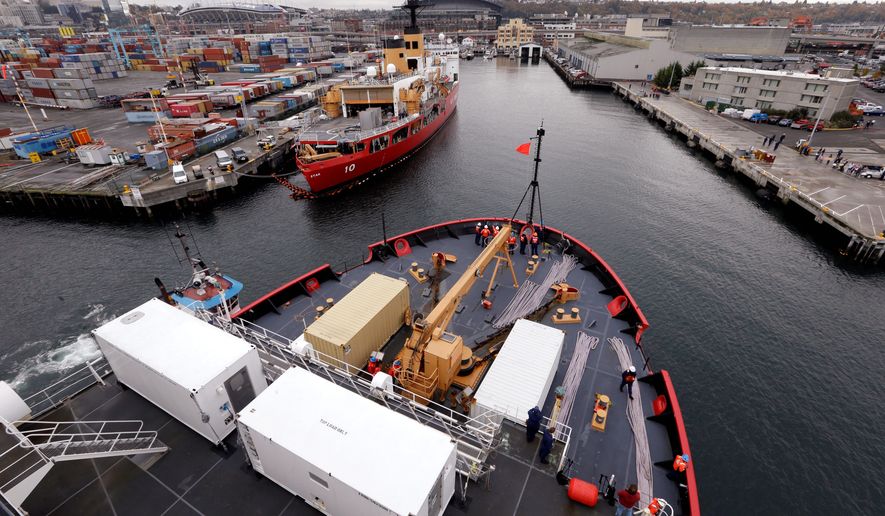Russian President Vladimir Putin not only is lurking in the Middle East and Eastern Europe but also is building up military forces in the expansive Arctic as the U.S. watches.
Rep. Duncan Hunter, a California Republican whose House subcommittee oversees Coast Guard policy, said the U.S. is losing the battle for the Arctic and needs to fight back with at least one basic weapon — icebreakers — to ensure American access. Russia deploys nearly 40, the U.S. only two.
The U.S. Coast Guard says it needs three “medium” and three “heavy” ice plows but sails only the 1970s Polar Star (heavy) and the 2000 Healy (medium) in what is an increasingly busy and contested region.
Mr. Hunter, chairman of the House Transportation and Infrastructure subcommittee on Coast Guard and maritime transportation, has been working behind the scenes to help the Coast Guard (which operates on a relatively small $10 billion budget) to press Congress and the White House for more money.
He also arranged a marriage between the Coast Guard’s ship-buying office and the Navy so that the Coast Guard can reap some of the larger service’s expertise. The Coast Guard has not designed and bought a heavy icebreaker in decades.
“Russia is working overtime to strengthen its Arctic presence while the U.S. is acting like a bystander and a nation without any similar strategic interests,” Mr. Hunter told The Washington Times. “With new icebreaking capability, we can exponentially strengthen our presence and guarantee year-round access for reasons of national security, commerce and research.”
The post-Cold War Arctic has ranked low in regional priorities, but the Pentagon has begun to pay more attention. It issued strategy papers under President Obama. It stripped away various commands that had a piece of the polar north and consolidated full responsibilities to U.S. Northern Command. The Coast Guard, the country’s fifth military branch, operates under the Department of Homeland Security.
Coast Guard Vice Adm. Charles W. Ray, deputy commandant for operations, told The Times that the plan is to deliver by 2023 the first heavy icebreaker since the 1970s.
“Timely replacement of our one, aging operational heavy icebreaker is vital to the advancement of U.S. interests,” Adm. Ray said. “We need to maintain a level playing field with other nations that have invested heavily in their national icebreaking capabilities.”
Long term, he said, “our threshold requirement for year-round access and to protect national security, economic, environmental and maritime interests is three heavy and three medium icebreakers.”
Mr. Hunter wants to create a “block buy” for two additional heavy icebreakers once the first $1 billion ship is funded.
The former Marine officer wrote a letter Friday to two Cabinet secretaries saying it is time to make the Coast Guard a higher priority.
“One of the most significant acquisition challenges facing the Coast Guard currently is the acquisition of heavy and medium icebreakers,” Mr. Hunter wrote to Defense Secretary James Mattis and Homeland Security Secretary John F. Kelly.
“You are intimately familiar with the urgency to develop these assets in short order,” the congressman said.
There is a feeling among pro-Coast Guard lawmakers that the branch is too shy when it comes to making its budget arguments. To that end, Mr. Hunter sent another letter Feb. 10 asking Adm. Paul F. Zukunft, Coast Guard commandant, to submit an “expansive” list of priorities that Congress has not funded.
The “urgency” of which Mr. Hunter wrote revolves around Mr. Putin, whose aggressive foreign policy includes expanding his military’s reach among 5 million square miles of Arctic ice and water.
The stakes are high, given the need for the free flow of shipping along the Arctic Ocean, whose seafloor holds large gas and oil reserves. Which countries hold rights to those resources at various locations is still unsettled.
Claims on Arctic territory are made by five coastal nations: Canada, Denmark, Norway, the U.S. (via Alaska) and Russia.
A Congressional Research Service report, coordinated by naval analyst Ronald O’Rourke, explains the complex and icy playing field.
Mr. Putin has made a number of moves by dispatching military brigades, planning a large shipping port on Siberia’s Yamal peninsula and rebuilding old air bases.
“Russia will definitely expand its presence in the Arctic,” Mr. Putin said in 2011, according to the Jan. 5 CRS paper. “We are open for dialogue with our foreign partners and with all neighbors in the Arctic region. But we will naturally defend our own geopolitical interests firmly and consistently.”
ForeignPolicy.com in January reported that Mr. Putin is bent on militarizing more Arctic territory.
He has opened 14 airfields and 16 deep-water ports, while launching more icebreakers.
Foreign policy analysts say Mr. Putin views gas, oil and uranium not only as energy sources but also as negotiating tools to bully other countries.
To the two functioning U.S. icebreakers, Mr. Putin can call on 37, with four more under construction and eight more planned.
Wrote Mr. O’Rourke: “Renewed tensions with Russia following its seizure and annexation of Crimea in March 2014, combined with a significant recent increase in Russian military operations in the Arctic, have led to growing concerns among observers that the Arctic is once again becoming a region of military tension and competition, and to concerns about whether the United States is adequately prepared militarily to defend its interests in the region.”
A 2013 Defense Department strategy paper said: “The Arctic is at a strategic inflection point as its ice cap is diminishing more rapidly than projected and human activity, driven by economic opportunity — ranging from oil, gas, and mineral exploration to fishing, shipping, and tourism — is increasing in response to the growing accessibility.”
The Pentagon set aside $6 billion this year to fulfill that strategy.
• Rowan Scarborough can be reached at rscarborough@washingtontimes.com.




Please read our comment policy before commenting.